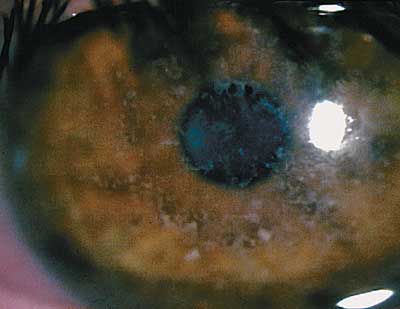
Q: I recently saw a 27-year-old female post-LASIK patient who suffers from multiple episodes of recurrent corneal erosion (RCE) due to a leaky epithelium. What course of action should I take with this patient?
A: Follow this stepladder of treatment:
Prescribe a lubricant. Start this patient on a hypertonic ointment, such as Muro 128 (sodium chloride, Bausch & Lomb), to be used at bedtime. This should draw any fluid out from under the epithelium and allow the epithelium to lay flat, says ophthalmologist Thomas S. Boland, of Scranton, Pa. In addition, the ointment provides good lubrication so [that] the lid will not stick to the epithelium and lift it off during sleep.
Optometrist Robert Ryan, of Rochester, N.Y., agrees. I prescribe the ointment instead of the drops because I have found the drops, due to their hypertonic nature, can sting and cause epiphora, which dilutes the concentration of the drop and therefore limits its efficacy, he says. Dr. Ryans advice: Prescribe the ointment q.i.d. (morning, noon, dinnertime and bedtime), with particular emphasis on use prior to sleep and upon waking. Use prior to bedtime is important be-cause recurrent erosion typically occurs upon waking, Dr. Ryan says. Because the cornea is equilibrating and recovering from normal edema during sleep, the patient can complement this process by using the ointment upon waking.
Ophthalmologist David A. DeRose, of Wilkes-Barre, Pa., suggests prescribing over-the-counter preservative-free tears and ointments, such as GenTeal (Novartis) and Refresh PM (Allergan) to alleviate dryness, which is often the problem, he says.
If none of these agents work alone, employ oral doxcycline, which has a strong matrix metalloproteinaise-9 (MMP-9) inhibitory activity, as adjunctive therapy, Dr. DeRose says. Prescribe 50mg p.o. b.i.d. for a minimum of two weeks if the patient is not on iron supplementation, avoids the sun and has no allergies to this family of medication, he says. Some patients respond to two weeks on doxycycline; others take longer. If no benefit has been gained by two to three months, stop this therapy, and investigate other therapies, Dr. DeRose says.
Prescribe a hydrophilic-bandage contact lens. Do this if lubrication does not alleviate the problem. Dr. Ryan suggests using a low-modulus silicone hydrogel lens, which tends to be less insulting to the corneal surface (particularly on an already compromised corneal surface) than a high-modulus lens.
Place the patient in this lens for between six to eight weeks, 24 hours a day, perhaps replacing at three to four weeks or as necessary due to soilage, he adds. The lens allows the epithelium to heal without disruption from the blinking action. The epithelium will heal between one to three days, but keep the patient in the lens for a number of weeks to allow the basement membrane to reorganize its hemidesmosomes and anchoring fibrils, which secure the epithelium to the underlying structures.
You might choose to prescribe oral doxycycline in conjunction with the bandage contact lens to inhibit MMP-9, Dr. Ryan adds. This reduces inflammation.
Besides a bandage lens, consider punctal plugs as an adjunctive form of therapy. If the patient is very dry, place a punctal plug in both the lower and upper lids to provide a moist environment for the epithelium to remain secure, Dr. DeRose says. It becomes easily denuded when dry. (Editors note: Doxycycline, in conjunction with corticosteroids, can rapidly resolve and prevent the further recurrence of RCE in patients unresponsive to the more conventional therapies.1)
 |
| RCE unresponsive to conventional therapies can be resolved by doxycycline along with corticosteroids. |
Refer for a procedural intervention. If the bandage contact lens does not work, consider one of five interventions. One such intervention: debriding and polishing the patients epithelium with a diamond burr. Still, you have to be very careful using a diamond burr in a patient who has undergone LASIK because its a rotating instrument, and you could disrupt the flap and induce diffuse lamellar keratitis, Dr. Boland says. So, use it very, very gently with minimal pressure on the underlying flap, and only as a last resort.
Dr. Ryan recommends debriding the patients epithelium with a Beaver blade. Basically, you scrape the corneal surface to remove the epithelium down to Bowmans membrane, which essentially cleans up all the defective basement membrane and allows it to heal over with new, stronger hemidesmosome attachments, he says.
Other options: stromal micropuncture and phototherapeutic keratectomy (PTK). Stromal micropuncture, typically done with a 25-gauge needle, makes a series of very small punctures to the superficial cornea. This apparently recruits factors that help to encourage new epithelial cells to grow, Dr. DeRose says. PTK ablates through the epithelium and deeper down into Bowmans tissue. The procedure seemingly recruits epithelial cells to come back in and hopefully secure themselves more closely to denuded tissue in order to make the patient a new epithelium.
An adjunctive therapy to epithelium removal via PTK or debridement: a drop of ones own serum into his or her eye (autologous serum).2 Some local blood banks will draw the patients blood, spin out her blood cells and give her a bottle of her own serum to be kept refrigerated. It is used b.i.d. to q.i.d. for two to three days in the post-PTK eye, says Dr. DeRose. Factors in the blood itself encourage the deposition of the basement membrane and thus help to fix the collagen and keep the epithelium growing back.
Discuss diet and lifestyle with the patient. Patients who have RCE often are smokers, drink a lot of coffee and eat spicy and salty foodsall of which cause dehydration and worsen the condition. If this is the case with this patient, encourage her to decrease her intake of these things and to eat healthier, hydrating foods, such as salads, says Dr. DeRose. Also, prescribe flaxseed oil supplements, vitamin C and a multivitamin, as these things promote hydration as well.
1. Dursun D, Kim MC, Solomon A, Pflugfelder SC. Treatment of recalcitrant recurrent corneal erosions with inhibitors of matrix metalloproteinase-9, doxycycline and corticosteroids. Am J Ophthalmol 2001 Jul;132(1):8-13.
2. Kojima T, Ishida R, Dogru M, et al. The effect of autologous serum eyedrops in the treatment of severe dry eye disease: a prospective randomized case-control study. Am J Ophthalmol 2005 Feb;139(2):242-6.

